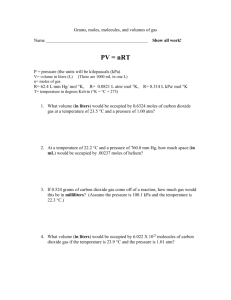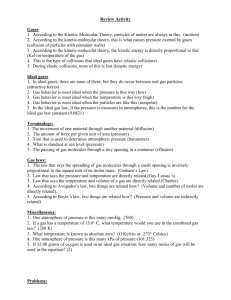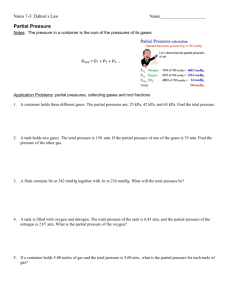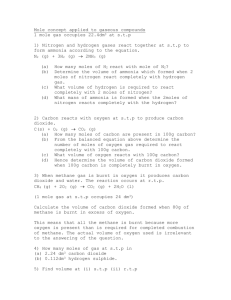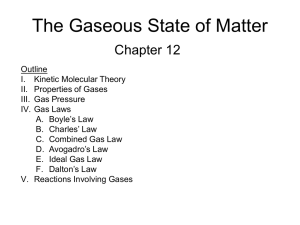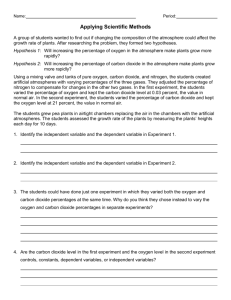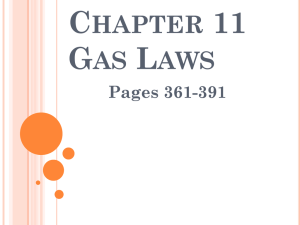Ch. 10 Test Review: Gases
advertisement
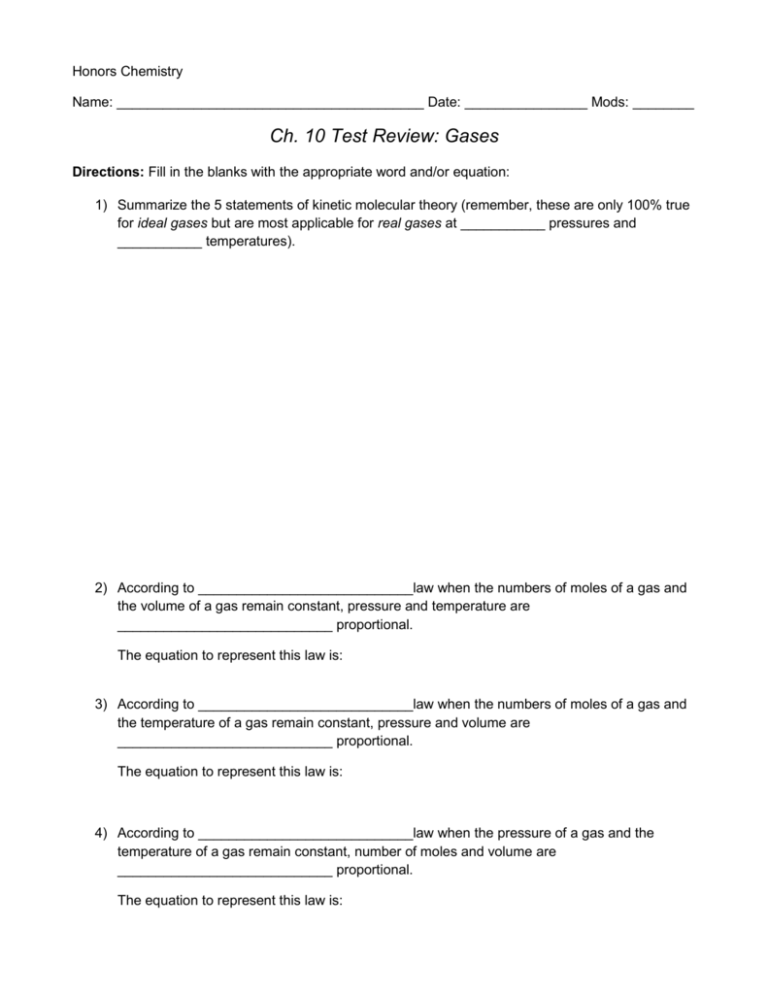
Honors Chemistry Name: ________________________________________ Date: ________________ Mods: ________ Ch. 10 Test Review: Gases Directions: Fill in the blanks with the appropriate word and/or equation: 1) Summarize the 5 statements of kinetic molecular theory (remember, these are only 100% true for ideal gases but are most applicable for real gases at ___________ pressures and ___________ temperatures). 2) According to ____________________________law when the numbers of moles of a gas and the volume of a gas remain constant, pressure and temperature are ____________________________ proportional. The equation to represent this law is: 3) According to ____________________________law when the numbers of moles of a gas and the temperature of a gas remain constant, pressure and volume are ____________________________ proportional. The equation to represent this law is: 4) According to ____________________________law when the pressure of a gas and the temperature of a gas remain constant, number of moles and volume are ____________________________ proportional. The equation to represent this law is: 5) According to ____________________________law when the numbers of moles of a gas and the pressure of a gas remain constant, temperature and volume are ____________________________ proportional. The equation to represent this law is: 6) The _______________________ gas law is used when the temperature, pressure, and volume of a gas are all changing conditions but the number of moles remains constant. The equation to represent this law is: 7) The ideal gas law is represented by the formula ___________________________ where R is the ideal gas constant equal to _________________ when the units are _________________. This law can be rearranged to solve for density, mass, or molar mass of a gas. 8) Standard temperature and pressure are ___________ atm (or ___________ torr = ____________ kPa) and _______ ºC (or __________ K). At STP conditions only, the molar volume of a gas can be used: 1 mole of any gas = _____________ L. 9) What is the equation the solves for the partial pressure of a gas and involves the total pressure of a gas mixture and the mole fraction of the gas? Directions: Solve the following problems about gases. Show all work and include units. 10) An empty potato-chip bag is accidentally packaged at sea level (760 torr) and has a volume of 315 mL. If this bag is then transported to Denver where the atmospheric pressure is 0.775 atm, what will be the new volume of the bag be? 11) There is an unknown volume of gas at a pressure of 0.5 atm and a temperature of 325 K. If the pressure of the gas is raised to 803 mm Hg and the temperature is decreased to 311 K, with a measured final volume to be 23.8 liters, what was the initial volume of the gas? 12) Calcium carbonate decomposes at high temperatures to form carbon dioxide and calcium oxide according to the following balanced reaction: CaCO3 (s) CO2 (g) + CaO (s) If 13.7 g of calcium carbonate is decomposed at 1.0 atm and 25ºC, what volume, in liters, of carbon dioxide will form? 13) Ethylene burns in oxygen to form carbon dioxide and water vapor according to the unbalanced reaction below: ______C2H4 (g) + ______O2 (g) ______CO2 (g) + ______H2O (g) At 96.5 kPa and 34ºC, how many grams of water can be formed if 1.25 liters of ethylene are consumed in this reaction? 14) Assume that 8.5 L of iodine gas (I2) are produced at STP according to the following balanced equation: 2 NaI (aq) + Cl2 (g) → 2 NaCl (aq) + I2 (g) What mass of sodium chloride will also be produced from this reaction? 15) It is not safe to put aerosol canisters in a campfire, because the pressure inside the canisters gets very high and they can explode. If I have a 1000 mL canister that holds 2 moles of gas, and the campfire temperature is 1400ºC, what is the pressure, in mm Hg, inside of the canister? 16) A closed metal tank contains three gases: oxygen, helium, and nitrogen. If the partial pressures of the three gases in the tank are 35 atm of O2, 5 atm of N2, and 25 atm of He, what is the total pressure inside of the tank? 17) The mole fraction of nitrogen in air is 0.78 (that is, 78% of the molecules in air are N2). If the total barometric pressure is 760 torr, what is the partial pressure of N2 in the air? 18) From data gathered by the space probe Voyager 1, scientists have estimated the composition of Titan’s atmosphere (Saturn’s largest moon). The total pressure on the surface of Titan is 1220 torr. The atmosphere consists of 82 mole percent N2, 12 mole percent Ar, and 6 mole percent CH4. Calculate the partial pressure of each of the gases in Titan’s atmosphere. 19) A mixture of 7 moles hydrogen gas, 3 moles of nitrogen gas, and 2.0 moles of oxygen gas are placed in a flask. When the partial pressure of the oxygen is 78.00 mm Hg, what is the total pressure in the flask? 20) A tank contains 480.0 grams of oxygen gas and 80.00 grams of helium gas at a total pressure of 7.00 atmospheres. Calculate the partial pressure of each gas in the tank. 21) When carbon dioxide gas is collected over water, the total pressure of the gas mixture at 25°C is 75.9 kPa. a. What is the partial pressure of the carbon dioxide gas collected? b. Under these same conditions, the carbon dioxide gas was originally generated by the decomposition of solid copper (II) carbonate (which formed carbon dioxide gas and solid copper (II) oxide). If 15.2 grams of copper (II) carbonate was decomposed, what volume, in mL, of carbon dioxide gas was collected? 22) Ammonia, NH3, is the most important commercial compound of nitrogen. It can be produced by reacting nitrogen with hydrogen gas. This is the process used to produce ammonia commercially and is known as the Haber process: N2(g) + 3H2(g) 2NH3(g) a. How many grams of ammonia are produced if 7.85 L of ammonia is collected at -15ºC and 5.93 atm pressure? Identify the gas law used. Problem 21 continued b. What is the density of ammonia at 22ºC and 745 mmHg? c. If 5.0 L of nitrogen gas at 12ºC and 1.30 atm pressure reacts with excess hydrogen gas, what volume of ammonia, in liters, will be produced? 23) In a mixture of sulfur dioxide and hydrogen gases there are 0.64 mols of sulfur dioxide and 0.21 mols of hydrogen in a 12.8 L container at 41ᵒC. a. What is the total pressure of the mixture of gases? b. What would be the volume, in liters, of the same mixture of gases at STP conditions? 24) Compare the rate of diffusion of carbon dioxide (CO2) & ozone (O3) at the same temperature. Which gas will diffuses faster?
